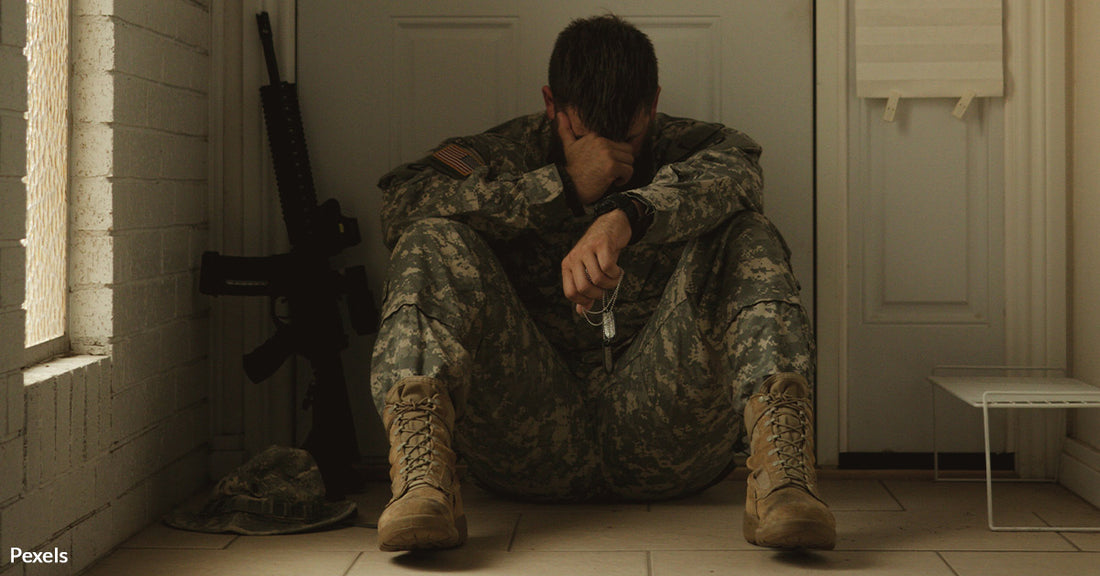New Study Reveals Disturbing Reality of Veteran Suicide Crisis
Matthew Russell
Pexels
The United States faces a heart-wrenching crisis that often goes unnoticed—the alarming rate of suicide among its veterans. While the official numbers are concerning, a study conducted by America's Warrior Partnership (AWP), in collaboration with the Department of Defense and the University of Alabama, suggests that the situation may be even graver than previously estimated. The study sheds light on this hidden epidemic, exposing errors in state and national data, and underscores the urgent need for action.
 Photo: Pexels
Photo: PexelsVeteran suicide rates may be significantly underreported, according to a recent study.
An Undercounted Tragedy
The AWP study examined data from eight states—Alabama, Florida, Maine, Massachusetts, Michigan, Minnesota, Montana, and Oregon—that voluntarily shared information on veterans' deaths. The findings reveal that these states may be undercounting veterans' deaths by as much as 25 percent, Newsweek reports.
According to a press release from AWP, the daily rate of suicide among veterans in these states is 1.37 times higher than what the Department of Veterans Affairs (VA) previously reported. If this alarming statistic were representative of the entire nation, the veteran suicide rate would be a staggering 2.4 times higher than previously reported by the VA. This means that, on average, 44 former service members died by suicide every day between 2014 and 2018, AWP maintains.
 Photo: Pexels
Photo: PexelsFinancial instability is linked to veterans' feelings of hopelessness and, subsequently, suicide.
Staggering Statistics
Suicide "is the single most significant health concern among veterans today," David Rudd, a veteran and professor of psychology at the University of Memphis, told Newsweek. "If you go back to the Vietnam War, the most significant health concern at the time was Agent Orange. Now it's suicide."
According to data from the VA, between September 2001 and 2019, over 30,000 veterans succumbed to suicide. To put this into perspective, this number is four times greater than the combined total of U.S. military personnel who lost their lives in combat during the Iraq and Afghanistan conflicts. According to the 2022 VA report, there were 6,146 veteran suicides in 2020, averaging 16.8 per day. While this figure is distressing, it does represent a slight decrease from the previous year.
 Photo: Pexels
Photo: PexelsIn 2020, there were 6,146 veteran suicides, with an average of 16.8 per day.
Examining 'Hopelessness'
Apart from analyzing veterans' causes of death and their health, the AWP study delved into veterans' interactions with law enforcement, their financial circumstances (including credit scores and loan rejections), and how these factors correlated with feelings of "hopelessness."
Jim Lorraine, president of America's Warrior Partnership and a veteran himself, noted a correlation between hopelessness and a higher suicide rate. Financial instability, in particular, appears to be a significant contributing factor to the overall sense of hopelessness among veterans and the general population.
"What we're seeing is that it's not just food insecurity or homelessness, what it comes down to is financial instability. It's big," he told Newsweek. "If a veteran fails to pay a credit card bill, their interest rates go up to 25 percent, and then their monthly bill the next month might be higher than they can afford."
 Photo: Pexels
Photo: PexelsIn eight states, the daily rate of veteran suicide was 1.37 times higher than previously reported by the VA.
The Transition Challenge
The transition from military to civilian life is exceptionally challenging for veterans. This unique transition can be a formidable obstacle. Scientific studies have shown that when veterans leave the structured environment of the military, they often lose their sense of purpose and support structure, leading to a profound sense of disorientation and isolation.
Civilian life is markedly different, and veterans must navigate unfamiliar terrain. They find themselves in situations where they must reintroduce themselves to peers, colleagues, and acquaintances, which can be daunting and exacerbate feelings of isolation, Performance.gov reports. This profound shift in identity and support structures is a critical factor in the crisis.
 Photo: Pexels
Photo: PexelsCommunities, families, and individuals all play roles in preventing veteran suicides.
Inadequate Support and Stigma
While numerous interventions could help veterans, there is a widespread lack of adequate support. According to the National Institutes of Health, one significant issue is the insufficient number of clinicians offering these interventions, particularly in rural areas where many veterans reside. Approximately a quarter of veterans live in rural regions, the VA reports where access to healthcare is more challenging than in densely populated urban areas.
The complexity of the transition from military to civilian life is further compounded by the stigma surrounding mental health issues. Approximately half of all Americans believe that seeking therapy is a sign of weakness, Forbes reports. In the general population, this number rises to nearly two-thirds. To address this crisis effectively, the barriers to accessing care and the associated stigma must be dismantled.
 Photo: Pexels
Photo: PexelsThe transition from military to civilian life is uniquely difficult and often leads to a loss of purpose.
A Call for Comprehensive Support
Recognizing the gravity of the veteran suicide epidemic, the VA introduced The COMPACT Act, a program allowing veterans in an "acute suicidal crisis" to receive free emergency mental health care. This program provides inpatient care for up to 30 days and outpatient care for up to 90 days with both VA and non-VA service providers.
To prevent veteran suicides, fostering these crucial national conversations and supporting individual veterans are paramount. It is not solely the responsibility of government institutions but requires the collective efforts of communities, families, and individuals. Veterans have served their country, and it is our collective duty to serve them in their time of need.
Click below to help make a difference.
Matthew Russell is a West Michigan native and with a background in journalism, data analysis, cartography and design thinking. He likes to learn new things and solve old problems whenever possible, and enjoys bicycling, spending time with his daughters, and coffee.




















